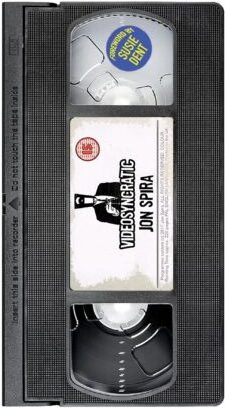By JON SPIRA (2017)
VIDEOSYNCRATIC is, first and foremost, one of the most strikingly designed books of the 2010s. The front and back covers were made to closely resemble a rental VHS, which is replicated in nearly every conceivable respect (including size). That’s appropriate given that the book is all about video, which has apparently defined its author’s life.
The Oxford bred Jon Spira claims to have been a videophile from age 7, when his family got a VCR and “the die was cast. By 8, my life was irrevocably dedicated to film. Dedicated to video. Dedicated to video shops.” That momentous introduction occurred in 1983, when home video was in the process of becoming a worldwide phenomenon; within a year everyone Spira knew had a VCR and the UK’s “video nasties” clampdown was picking up steam, while in another couple years Blockbuster Video, or “Blocky,” with which Spira became very closely related, entered the fray.
It was in his college years that Spira, then an aspiring filmmaker, first experienced working in a video store. It was at an Oxford Blocky, the first of many video shop jobs in the area. Included is a wealth of enjoyable info about Spira’s many eccentric co-workers and supervisors, and the revelation of insider lingo like “moving the wall” (referring to the weekly shuffling of Blockbuster’s New Release wall), “PVTs” (or Previously Viewed tapes) and “Timecodes” (workprint versions of soon-to-be-released films, accessible only by store management). Spira later opened Videosyncratic, a funky cult-minded video store, and managed to add a second outlet before, in another mirroring of the overall state of the industry, the business collapsed in the early 2010s. Topping things off is a transcript of a 2007 conversation between Spira and a colleague, in which they discuss the state of home video, and so provide a boots-on-the-ground depiction of a once-thriving industry.
It was an industry that in its day didn’t seem too vital. This book provides a much-needed rectification of that sentiment, re-introducing us to an era when home viewing was a proactive (requiring taking videos from and returning them to a physical location) and even communal (as renting videos often involved verbal interactions with knowledgeable employees) experience.
Complaints? The book contains no photos, which seems odd given that the locations designated in the text, and Spira’s descriptions of them, are so specific. Further annoyance is provided by the abundance of typos and misplaced commas (which telegraph the fact that the book was self-published). But those things are forgivable in light of the boldness of the layout and consistently enjoyable content. This is a book that provides a potent blast of nostalgia for those who remember the video rental era, while showing younger readers precisely what they missed.



